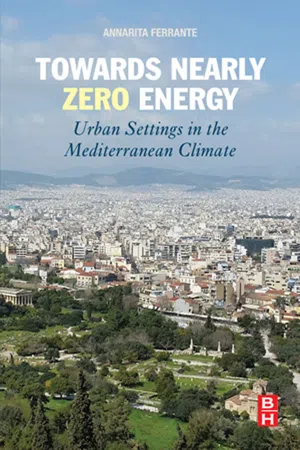
- 292 pages
- English
- ePUB (mobile friendly)
- Available on iOS & Android
About This Book
Towards Nearly Zero Energy: Urban Settings in the Mediterranean Climate discusses tactics that can be used to effectively reduce energy consumption towards zero energy. With energy usage in buildings accounting for over 40% of primary energy use and 24% of greenhouse gas emissions worldwide, this remains an unavoidable objective.
The book looks at the life of the systems of energy production from renewable sources amidst the exceptionally challenging global economic crisis that the Mediterranean areas and other societies are currently experiencing. By using an innovative and interdisciplinary approach of socio-oriented technological design, the book indicates tools and measures that can be developed at the public, legislative, and market levels to counterbalance the large pay-back times of energy efficiency measures.
In particular, the book displays guidelines and best practices to activate new forms of economic incentives in order to attract potential investors that demonstrate that a large set of possible solutions is technically feasible to achieve nearly zero energy, even in high energy consuming circumstances and urban settings.
Furthermore, by discussing and comparing the economic and energy impact of different technology options, this work offers guidelines and best practices to activate new cost-effective forms and social incentives in order to attract both potential investors and motivate the urban stakeholders toward nearly zero energy.
- Strategies and zero energy solutions for practitioners
- Policy s and economic resolutions to combat legislative barriers
- Examples and case studies of nearly zero energy urban environments
Frequently asked questions
Information
The Framework of Urban Built Environments
Abstract
Keywords
1.1. Introduction
Table of contents
- Cover
- Title page
- Table of Contents
- Copyright
- Foreword
- Chapter 1: The Framework of Urban Built Environments
- Chapter 2: Nearly Zero Energy Urban Settings (ZEUS)
- Chapter 3: Understanding Economic Constraints to Achieve Nearly ZEUS
- Appendix
- Glossary
- Subject Index